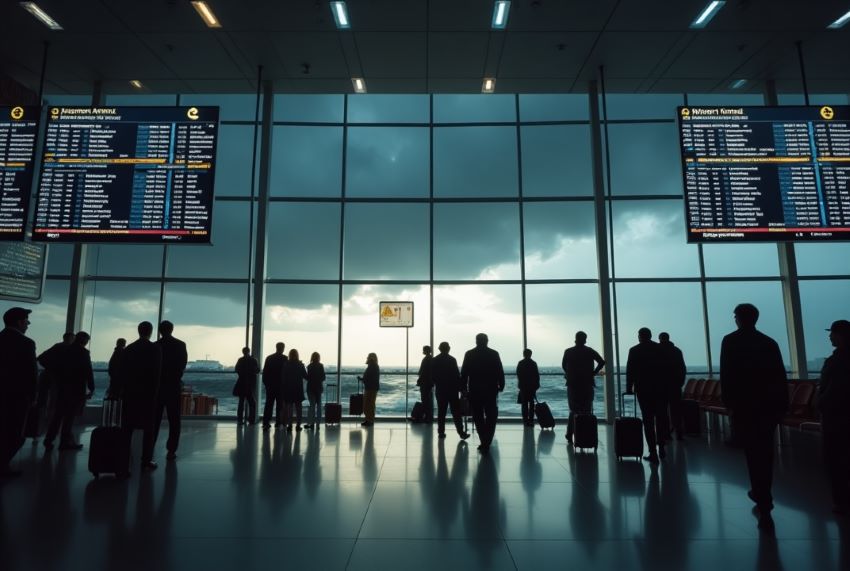читайте также
 Europe’s New EES Border System Launches in Chaos: Three-Hour Queues, Broken Kiosks, Unprepared Travelers, and Delays Up to 340%
Europe’s New EES Border System Launches in Chaos: Three-Hour Queues, Broken Kiosks, Unprepared Travelers, and Delays Up to 340%
 Every Square Foot Counts: How Hotels Turn “Dead Space” Into Revenue, Relevance, and Real Guest Value
Every Square Foot Counts: How Hotels Turn “Dead Space” Into Revenue, Relevance, and Real Guest Value
 Montenegro will introduce visas for Russians at the end of September 2026
Montenegro will introduce visas for Russians at the end of September 2026
 Tourists Are Damaging Tropical Cities: PATA Calls for Urgent Action
Tourists Are Damaging Tropical Cities: PATA Calls for Urgent Action
 Deadly Storms, Blizzards, and Tornadoes Slam the U.S. — How Millions Can Survive the Thanksgiving Weather Disaster
Deadly Storms, Blizzards, and Tornadoes Slam the U.S. — How Millions Can Survive the Thanksgiving Weather Disaster
 Housing Market in Tel Aviv 2025: Falling Prices and Declining Investor Activity
Housing Market in Tel Aviv 2025: Falling Prices and Declining Investor Activity
U.S. Introduces Dual Pricing in National Parks: What Will Change in 2026

U.S. national parks are preparing for the most significant funding reform in decades. Beginning in 2026, the system will introduce a dual pricing model: American citizens and residents will keep their familiar low rates, while foreign tourists will pay substantially more.
The initiative aims to secure long-term funding for parks — which welcome tens of millions of visitors every year — while maintaining affordability for U.S. residents, who already support the system through taxes.
The logic is straightforward: foreign visitors remain an essential source of tourism revenue, but Americans bear the primary financial responsibility for maintaining national parks. The new pricing structure reflects this balance more clearly than ever.
Americans: $80, Foreign Visitors: $250 — the New Annual Pass Fee
The most significant change concerns the America the Beautiful annual pass, which provides unlimited entry to all national parks across the country.
For U.S. citizens and permanent residents, the price remains $80. For foreign visitors, the cost will rise to $250, a 212% increase. For the first time, the system formally distinguishes between the contribution of American taxpayers and that of international guests.
The Department of the Interior (DOI) emphasizes that all additional revenue collected from foreign visitors will be fully reinvested into park infrastructure, including:
- trail restoration;
- facility modernization;
- improved safety and visitor services;
- upgraded visitor centers and navigation systems.
A shift to digital passes will also become mandatory: all annual passes will be issued via Recreation.gov, stored on a mobile device, and allow access without physical cards.
Top Parks Will Cost More for Foreign Visitors: Grand Canyon, Yellowstone, Yosemite, and More
In addition to the annual pass increase, foreign tourists without one will pay an extra $100 per person when entering the country’s most popular national parks.
This list includes:
- Grand Canyon
- Yellowstone
- Yosemite
- Zion
- Bryce Canyon
- Acadia
- Everglades
- Glacier
- Grand Teton
- Rocky Mountain
- Sequoia & Kings Canyon
For a family of four without an annual pass, entry to the Grand Canyon may increase by an additional $400, not counting the standard base fee.
"Patriotic Days" Will Be Reserved for U.S. Citizens Only
Existing fee-free entry days — Presidents Day, Memorial Day, and Independence Day — will apply only to American citizens and residents starting in 2026.
Foreign visitors will still be required to pay standard entry fees on these dates.
This measure reinforces the reform’s strategic objective: maintaining affordable access for Americans while increasing the contribution of international guests.
How the Changes May Affect International Tourism and Local Economies
Experts already warn that higher prices may influence the behavior of foreign visitors.
Potential impacts include:
a decline in international tourism to U.S. national parks;
lower hotel and campground occupancy in gateway towns;
reduced revenue for local businesses — restaurants, tour operators, car rental companies;
a shift in travel flows toward other countries with more flexible pricing.
Because foreign tourists often spend more than domestic travelers, the new model could create economic challenges for regions heavily dependent on international tourism.
Why the U.S. Is Moving Toward Dual Pricing
According to the DOI, the national park system is facing chronic underfunding. Costs for repairs, trail erosion control, road maintenance, and sanitation rise every year. Meanwhile, international visitation continues to increase, placing additional pressure on infrastructure.
The agency argues that American taxpayers should not bear the full financial burden.
Under the new policy, foreign visitors will become the primary additional contributors to modernization and upkeep.
Experts from International Investment note that the reform appears balanced — but its consequences are far from straightforward:
Pros:
- Increased funding for national parks without burdening American citizens.
- Accelerated digitalization and replacement of outdated access systems.
- Improved infrastructure quality and visitor safety.
Cons:
- Higher fees may discourage tourists from Europe and Asia — key markets for the U.S.
- Threats to regional economies dependent on international visitation.
- Reinforcement of the perception of the U.S. as an expensive destination.
The dual pricing model can secure sustainable funding for national parks, but it may also reduce the United States’ competitiveness in the global tourism market. The success of the reform will depend on whether international visitor numbers remain at acceptable levels.





